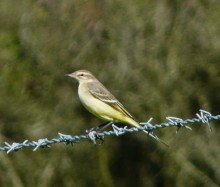As soon as we turn the calendar page over from July to August it seems the days start to shorten faster and there is a definite change to the morning air. If we notice it from the shelter of our warm, lit homes then you can be certain our wildlife does too and for some species of birds it is a sure sign they should be thinking about heading south on their annual migration cycle. Birds we see little of in June and July suddenly start appearing, particularly in coastal locations in early August and the numbers steadily grow during the month. Wheatear, whinchat, pied and spotted flycatchers, redstart, sand martin and various species of warbler all start their exit in August to make the long journey back to Africa for the winter. Towards the end of August this year there were sightings of flocks in the hundreds of yellow wagtail from various locations along the coast, usually in fields with cows in. Why in cow fields? Obvious really, cows mean cow pats, cow pats mean flies and flies mean dinner for yellow wagtails. Although one may encounter a flock of these birds in a location one day they are often gone the next, a sure sign that they had just stopped off on the Dorset coast for a last meal before heading out across the sea towards France and Spain.
Although the smaller birds are heading south in August there is still little sign of the waders and water fowl that over winter on our shores. As the month progresses so numbers of dunlin, ringed plover, godwits and other waders increase slowly but the ducks, geese and grebes are still to be seen.
The big news this August was the first recorded British occurrence of an American Yellow Warbler. It was found on Portland (of course!) and soon attracted lots of people to see it and it even made the BBC South Today news. Sadly for many visitors who made a long journey to see it the day after the discovery the bird only stayed the one day before disappearing over night and many were left disappointed. A common species in North America this poor bird seems to have got caught up in the maelstrom of hurricane Gertrude off of the coast of the USA and found itself cast adrift on the winds before making land fall here. Various other strangers turned up during August but nothing to quite compare with the yellow warbler. (see the full list on the Nature of Dorset website – https://www.natureofdorset.co.uk/records-diary/august-2017).
The other main talking point in the local bird world during August was the release of six young osprey fledglings in the Poole Harbour as part of a project intended to encourage them to breed in the area. The UK population has grown considerably in recent years having almost been exterminated at one point but lots of hard work from conservationists has seen them recover but because they nest close to where they were born many young ones struggle to set up a successful breeding territory as the older birds ‘encourage’ them to move on. It is hoped that these six young fledglings from further north will look upon Poole Harbour as their home and will set up territories here when they are old enough to breed in a couple of years time.
Away from birds August is a good month for butterflies and the Dorset speciality species of Adonis blue, Lulworth skipper and silver-spotted skipper were about in fair numbers during the month. There were also a number of migrant moth sightings with hummingbird hawk-moths and scarce bordered straws seemingly coming in good numbers. A recent moth species to colonise the area, the Jersey tiger, was seen from a number of locations and appears to be establishing itself strongly on the Dorset coast
With the early spring many plants had bloomed and set seed by the time August came but towards the end of the month autumn lady’s tresses (an orchid species) and autumn gentian started to appear, a sure sign to botanists that the season is coming to an end.
Peter Orchard







